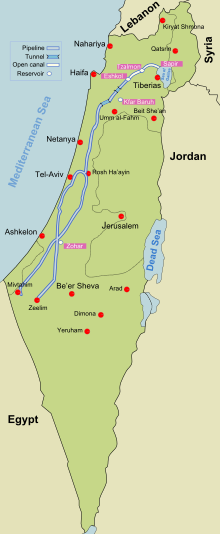National Water Carrier
The National Water Carrier ( Hebrew המוביל הארצי HaMowil haArtzi ; in German occasionally also "(Israelische) Landeswasserleitung") is an Israeli canal and pipe system, with which large parts of the country in the south are supplied with drinking water from the water-richer north of Israel. The water is transported from the Sea of Galilee to the Negev desert.
background
Israel's water supply is faced with a number of problems. Due to increasing irrigation in agriculture, water consumption has risen sharply over the past decades; the irrigated area has increased more than tenfold - within only 50 years - from 30 km² in 1938 to over 400 km² in 1990. The available water reserves, on the other hand, are small: There are hardly any rivers or lakes that carry water all year round and the groundwater reserves are limited. Another problem is the uneven temporal and spatial distribution of precipitation. The main amount of rain falls in winter, when less water is needed anyway, as there is hardly any need for irrigation. On the other hand, it does not rain at all in summer during the main demand time. In addition, rainfall can vary considerably from year to year. Another problem is the regional distribution of the water: around three quarters of the usable water is located north of Tel Aviv , while in the south at the transition to the Negev desert there are large areas that can be used for agriculture with appropriate irrigation.
Because of this situation, Israel's main goals in dealing with water are to store water and transport it from the north to the south. There is no way to fall back on natural watercourses: Most Israeli rivers are quite short, run in an east-west direction and flow into the Mediterranean Sea . The only larger river that flows south is the Jordan , which, however , is difficult to use as a supply channel, not least because of its location below sea level (and thus also below the areas to be supplied).
Against this background, all of Israel's water resources were nationalized in 1959 with the aim of better use, and various bodies and societies were founded to plan and control water use and develop the infrastructure. The Mekorot company is responsible for the construction and operation of larger waterworks . Through various measures, Israel has been able to optimize the use of its water over the past decades. So could z. B. the consumption can be reduced by drip irrigation . The enrichment of the groundwater through surface water in winter, the development of new wells and the desalination of seawater serve to improve the use of water . The construction of the state water pipeline was also a key element in the effort to make better use of the available water.
Since the system was set up, Israel's population has nearly tripled to seven million. In the same time, water consumption has increased by only three percent, while agricultural production has increased ninefold.
The state aqueduct
The approximately 130 km long supply system was completed in 1964. Jordan and Syria responded with the Headwater Diversion Plan , according to which the headwaters of the Jordan , the Banyas Stream and the Hasbani , should be diverted onto their territory. This in turn led to diplomatic and then military clashes, which in 1967 culminated almost seamlessly in the Six Day War. With the occupation of the Golan Heights in 1967 Israel secured control of the Jordan source river Banyas and with the Lebanon War in 1982 control of the Hazbani .
See also
Web links
- History of the National Water Carrier ( Memento from June 13, 2008 in the Internet Archive )
- Water as a conflict factor in the Middle East Deutsche Welle, March 13, 2006
- GIO Report Water (PDF; 3.3 MB) accessed on October 24, 2013
Individual evidence
- ↑ See the entire section on the water balance: Yehuda Karmon : Israel: Eine Geographische Landeskunde . 2nd Edition. Darmstadt 1994, pp. 107-111
- ^ Shmuel Kantor: The National Water Carrier. University of Haifa , accessed July 13, 2012 .
- ↑ Torsten Wöhlert: Strawberries from the desert on Friday , January 21, 2000


